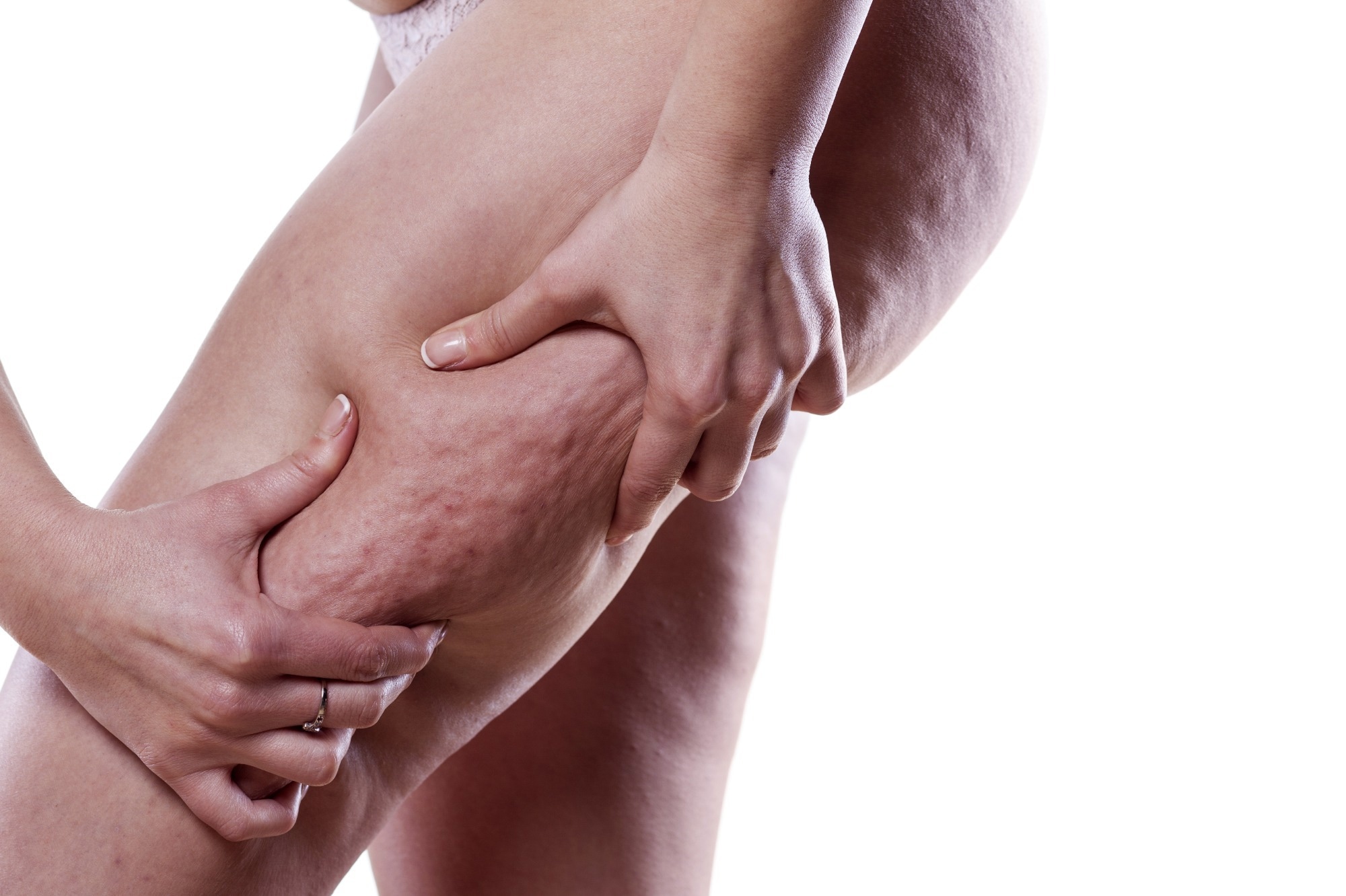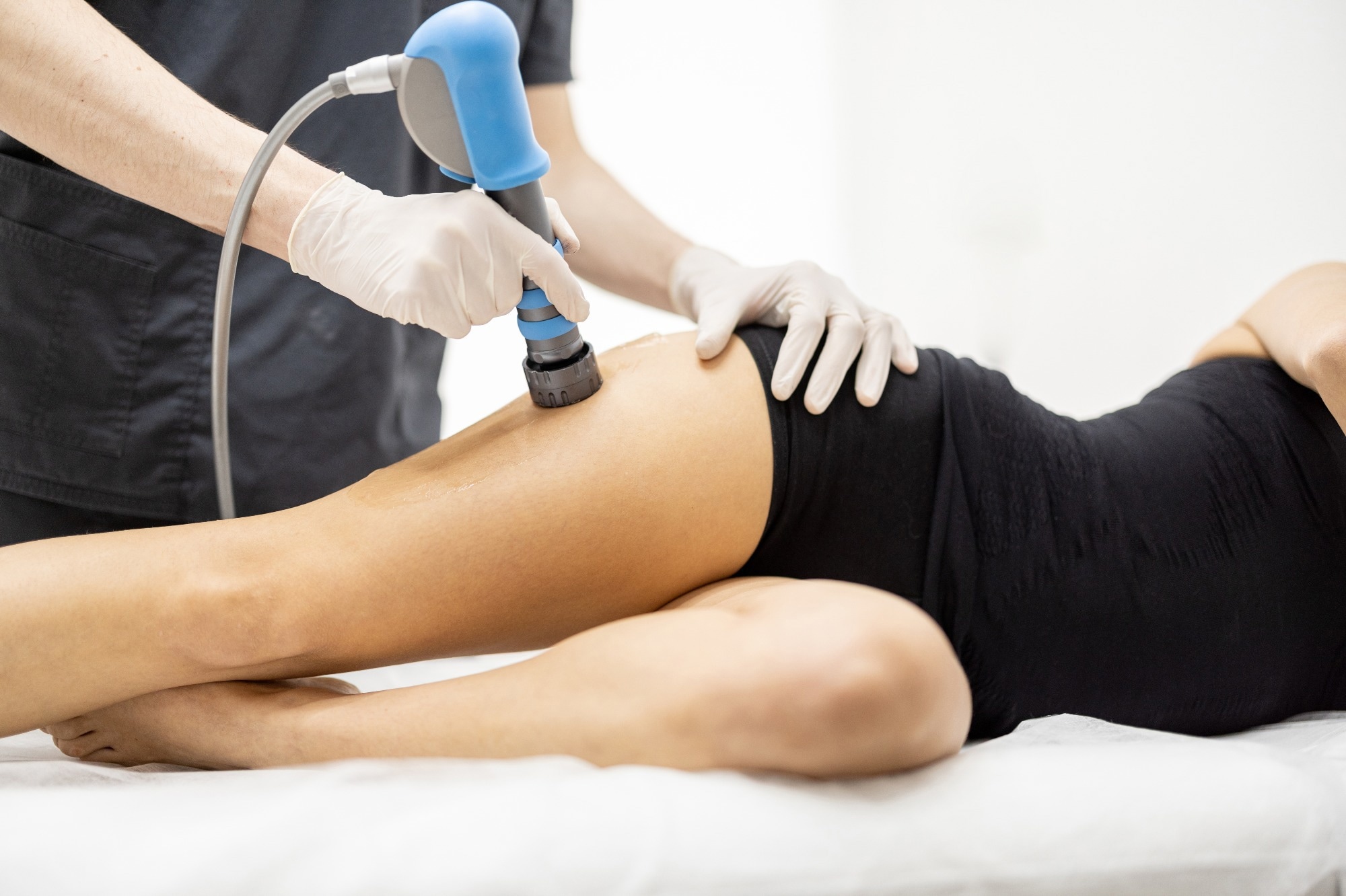Introduction
Risk factors for cellulite development
Cellulite grading
Cellulite treatment
Alternative treatments
Cosmetic surgery
References
Further reading
Introduction
Cellulite is a condition that is characterized by a dimpling, puckering, or “orange peel” appearance of the skin that is most commonly seen on the thighs, stomach, and buttocks. In some cases, cellulite is visible on the breasts, lower abdomen, and upper arms.
The prevalence of cellulite in postpubertal women ranges from 85% to 98%, while it is rare in men. The condition is caused by uneven movement of the fibrous cords that connect the skin to the muscles underneath. As fat accumulates, some fibrous cords press against the skin while others pull down, causing an irregular, dimpling effect (uneven surface).
Weight gain can increase the visibility of cellulite, but the condition afflicts lean individuals too.
 Cellulite. Image Credit: Vladimir Gjorgiev / Shutterstock
Cellulite. Image Credit: Vladimir Gjorgiev / Shutterstock
Risk factors for cellulite development
- Female gender - Cellulite is significantly more common in women than in men. The condition is only seen among men deficient in male hormones. Compared with men, the fat in females is more densely distributed in the thighs, buttocks, and hip areas where cellulite is most likely to occur. Also, women produce more estrogen during pregnancy and adolescence, which is also thought to play a role in the formation of cellulite, although evidence to support this is lacking. Furthermore, in women, the fibers constituting the connective tissue run in the same direction and are parallel, while in men, the connective bands crisscross together. Since parallel bands may show puckering better than crisscross bands, cellulite is more common in women than men. In women, for every beta-adrenergic receptor in the thigh, there are nine alpha receptors. Alpha receptors cause fat cells to produce fat, triggering constriction of blood vessels and the release of sugar into the bloodstream. Conversely, beta receptors break down fat, increase heart rate and relax blood vessels. Men have a single layer of fat throughout their bodies and a one-to-one alpha- and beta-receptor ratio. Women have three layers of fat in the knees, saddlebags, buttocks, and the stomach and triceps areas.
- Aging - Cellulite is more likely to occur with aging, as the skin gradually loses its elasticity.
- Hormonal factors - Hormones are thought to play an essential role in forming cellulite. When estrogen starts to decrease, typically as women begin to approach menopause, women lose receptors in the blood vessels of their thighs. As a result, with reduced circulation, less oxygen and nutrition reaches that area, which, in turn, reduces collagen production. At the same time, fat cells become more extensive and start protruding from the collagen, appearing as bumps that characterize cellulite. Aside from estrogen, other hormones, including insulin, adrenaline, noradrenaline, thyroid hormone, and prolactin, are all thought to contribute to the development of cellulite.
- Genetics - Research suggests a genetic element to cellulite and has pointed at mutations in the angiotensin-converting enzyme (ACE) gene as causative of the condition, for example.
- Stress - A stressful lifestyle is thought to raise the catecholamines adrenalin and noradrenaline levels, which are believed to be involved in the development of cellulite.
- Inflammation - An inflammatory basis for the pathogenesis of cellulite has been suggested. One study reported that macrophages and lymphocytes were dispersed throughout the fibrous septae of cellulite biopsies.
- Eating habits - A high-calorie diet comprising carbohydrates, fats, food preservatives, and salt may contribute significantly to the development of cellulite.
Cellulite grading
Cellulite presents in four grade symptoms as mentioned below:
- Grade 0: When there isn’t any visible cellulite.
- Grade 1: While standing, the skin is smooth, but mild dimpling appears in the sitting position
- Grade 2: Skin has moderate dimples in standing as well as sitting position
- Grade 3: Skin has severe dimples in both sitting and standing positions and deep raised and depressed areas.
Cellulite treatment
Cellulite is a common, harmless skin condition most prevalent in women. Since it is an asymptomatic cosmetic condition and does not cause pain, no treatment is required.
The U.S. Food and Drug Administration (FDA) has approved Cellfina®, Cellulaze®, and Qwo® for cellulite treatment. Although these medically proven treatment options for cellulite improve the appearance of dimples on the skin, they do not give immediate or long-lasting relief. On the contrary, regular exercise, including running, cycling, and resistance training, could help increase muscle mass to flatten cellulite within two to three months.
Alternative treatments
In addition, some herbal products, such as Ginkgo biloba and grape-seed extract, which increase blood flow in the stomach, legs, and butt, could help reduce the appearance of cellulite. Cupping, a traditional Chinese healthcare practice wherein a healthcare provider place cups on parts of the body to generate suction that pulls the skin upwards, may also help reduce cellulite. For temporary cellulite reduction, dry brushing is quite effective. It uses a dry, stiff-bristled brush to massage and puffs the skin. Handheld massage devices, foam rollers, or cellulite rollers could also help break up cellulite. However, there is not enough evidence to prove if they improve the long-term appearance of cellulite.
 Ginkgo biloba. Image credit: Lunov Mykola / Shutterstock
Ginkgo biloba. Image credit: Lunov Mykola / Shutterstock
Cosmetic surgery
Furthermore, cosmetic surgeons offer a variety of cellulite treatments.
- Acoustic wave therapy breaks up cellulite using sound waves and requires six weeks of delivery time, with results lasting two to six months.
- Laser treatment helps thicken the skin, which reduces the prominence of cellulite.
- Mesotherapy involves the use of needles to inject drugs into the cellulite.
- Subcision treatment uses a needle to break up fibrous bands underneath the skin, causing cellulite. It yields results within a month of the first round of treatment.
- 0.3% retinol-based creams and lotions show noticeable results within six months of use
- Even deep massages, and spa treatments, helps puff up the skin making cellulite less noticeable.
 Acoustic wave therapy. Image Credit: RossHelen / Shutterstock
Acoustic wave therapy. Image Credit: RossHelen / Shutterstock
Other treatments include vacuum-assisted precise tissue release to fill out dimpled skin and using radial pulses to heat skin. In addition, some doctors recommend liposuction for cellulite treatment. However, it is effective only for body sculpting that requires excess fat removal from some areas of the body but could worsen cellulite, which is the fat that remains beneath the skin.
It is noteworthy that nearly all these treatments target dermis, adipose, fibrous septae, or a combination of these tissues. However, anatomical studies show that some specific tissues may be involved in cellulite development. Therefore, integrating anatomical data with data from clinical studies could improve the understanding of cellulite etiology and inform cellulite treatment strategies.
Regarding the etiology of cellulite, anatomical studies have shown that the presence of visible cellulite is associated with histologic changes in the collagen-rich fibrous septae and, to a lesser extent, with the dermis and adipose tissue compared to unaffected skin. Studies have also shown the significance of the number and type of septae in the etiology of cellulite.
Therefore, it is very likely that mechanical, surgical, or enzymatic approaches targeting the collagen-rich fibrous septae in cellulite dimples, with or without concomitant treatment of dermis or adipose, could improve skin topography and produce long-term improvement in the appearance of cellulite.
Further Reading